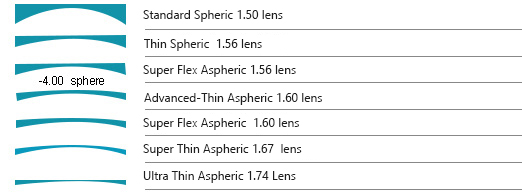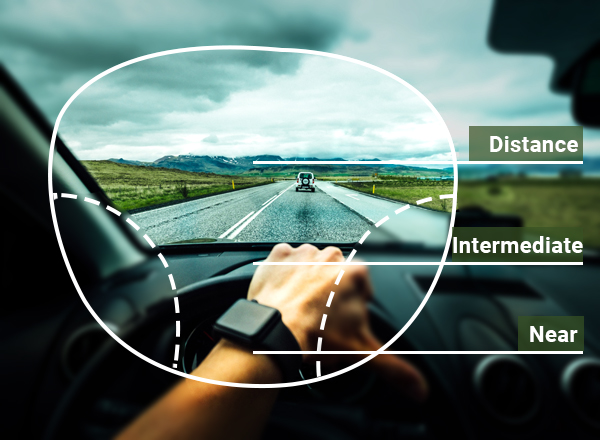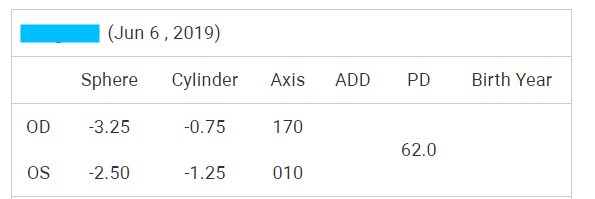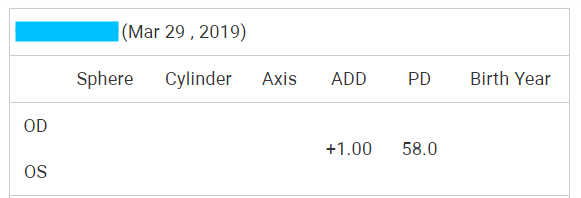a. Standard Spheric 1.50 Lens
Standard index 1.50 lenses are spheric lenses, they come an with anti-scratch hard coating and 85-90% UV protection coating (Please choose higher index lenses to get 100% UV protection), and are shatter-resistant, suitable for spherical power +/-1.00 or below, and cylindrical power +/-1.00 or below.
b. Super Flex Aspheric 1.56 Lens
Super flex 1.56 lenses are super light and highly impact-resistant with a 100% UV protection coating. These lenses are recommended for rimless and sports eyeglasses. The lenses are suitable for a spherical power of +2.00~+4.00/-2.00~-3.00 or below with cylindrical power +/-2.00 or below.
c. Thin Spheric 1.56 Lens
Thin Spheric (1.56) lenses come with an anti-scratch hard coating and 85-90% UV protection coating (Please choose higher index lenses to get 100% UV protection). The higher index lens greatly reduces the thickness of the lens edge, and they are suitable for spherical power of +2.00~+4.00/-2.00~-3.00 or below, and cylindrical power of +/-2.00 or below.
d. Super Flex Aspheric 1.60 Lens
Super flex 1.60 lenses are super light and highly impact-resistant with an anti-scratch hard coating and 100% UV protection coating. These lenses are recommended for rimless and sports eyeglasses. High index is suitable for spherical power of +4.00~+6.00/-3.00~-6.00 or below with cylindrical power +/-2.00 or to +/-3.00.
e. Polycarbonate Aspheric 1.59 Lens
Polycarbonate(PC) lenses are lightweight, comfortable and the most impact-resistant, with an anti-scratch hard coating and 100% UV protection coating. They are the best choice for children's glasses, safety glasses and sports eyewear. It is recommended for spherical power of +2.00~+3.00/-3.00~-6.00 with cylindrical power of +/-4.50 or below.
f. Advanced-Thin Aspheric 1.60 Lens
Advanced-Thin Aspheric (1.60) lenses are high index lenses with an anti-scratch hard coating and 100% UV protection coating which are suitable for wearers with spherical power from +4.00~+6.00/-3.00~-6.00, and with cylindrical power from +/-2.00 to +/-3.00.
g. Super Thin 1.67 Aspheric Lens
Super Thin Aspheric (1.67) lenses are light, thin and scratch-resistant with a 100% UV protection coating. Also, they are more impact-resistant than CR-39 resin lenses. They provide optical performance similar to glass lenses, as MR-7 lenses have a high index and Abbe number. The lenses are suitable for strong
a. Standard Spheric 1.50 Lens
Standard index 1.50 lenses are spheric lenses, they come an with anti-scratch hard coating and 85-90% UV protection coating (Please choose higher index lenses to get 100% UV protection), and are shatter-resistant, suitable for spherical power +/-1.00 or below, and cylindrical power +/-1.00 or below.
b. Super Flex Aspheric 1.56 Lens
Super flex 1.56 lenses are super light and highly impact-resistant with a 100% UV protection coating. These lenses are recommended for rimless and sports eyeglasses. The lenses are suitable for a spherical power of +2.00~+4.00/-2.00~-3.00 or below with cylindrical power +/-2.00 or below.
c. Thin Spheric 1.56 Lens
Thin Spheric (1.56) lenses come with an anti-scratch hard coating and 85-90% UV protection coating (Please choose higher index lenses to get 100% UV protection). The higher index lens greatly reduces the thickness of the lens edge, and they are suitable for spherical power of +2.00~+4.00/-2.00~-3.00 or below, and cylindrical power of +/-2.00 or below.
d. Super Flex Aspheric 1.60 Lens
Super flex 1.60 lenses are super light and highly impact-resistant with an anti-scratch hard coating and 100% UV protection coating. These lenses are recommended for rimless and sports eyeglasses. High index is suitable for spherical power of +4.00~+6.00/-3.00~-6.00 or below with cylindrical power +/-2.00 or to +/-3.00.
e. Polycarbonate Aspheric 1.59 Lens
Polycarbonate(PC) lenses are lightweight, comfortable and the most impact-resistant, with an anti-scratch hard coating and 100% UV protection coating. They are the best choice for children's glasses, safety glasses and sports eyewear. It is recommended for spherical power of +2.00~+3.00/-3.00~-6.00 with cylindrical power of +/-4.50 or below.
f. Advanced-Thin Aspheric 1.60 Lens
Advanced-Thin Aspheric (1.60) lenses are high index lenses with an anti-scratch hard coating and 100% UV protection coating which are suitable for wearers with spherical power from +4.00~+6.00/-3.00~-6.00, and with cylindrical power from +/-2.00 to +/-3.00.
g. Super Thin 1.67 Aspheric Lens
Super Thin Aspheric (1.67) lenses are light, thin and scratch-resistant with a 100% UV protection coating. Also, they are more impact-resistant than CR-39 resin lenses. They provide optical performance similar to glass lenses, as MR-7 lenses have a high index and Abbe number. The lenses are suitable for strong optical, with spherical power from +/-6.00~+/-9.00 and cylindrical power from +/-3.00 to +/- 4.00.
h. Ultra Thin 1.74 Aspheric Lens
Ultra Thin Aspheric(1.74) lenses come with a 100% UV protection coating and they are suitable for strong
A specific example is shown below on the indexing of a -4.00-lens optical on how thin the lens could be.













